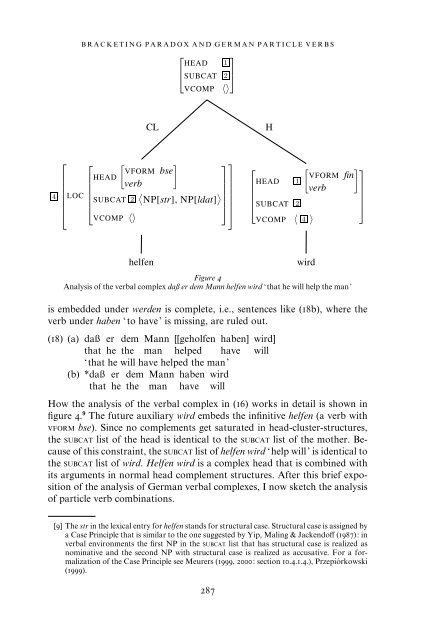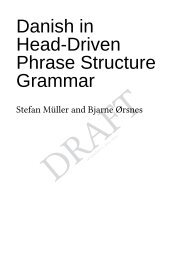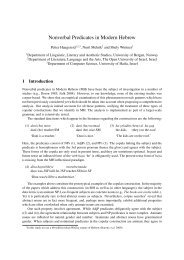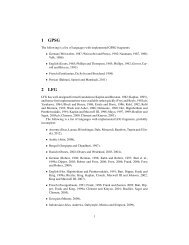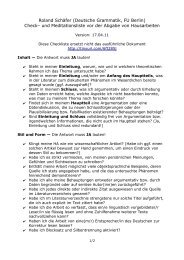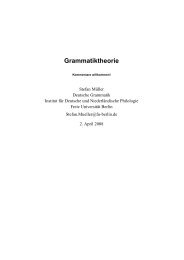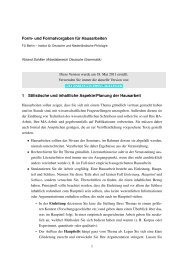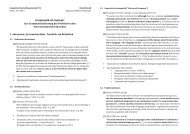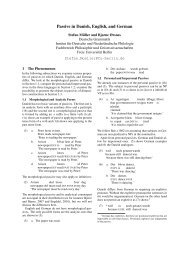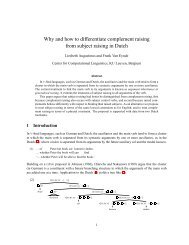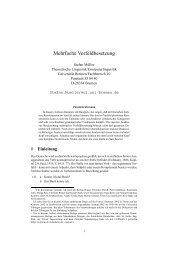Solving the bracketing paradox - German Grammar Group FU Berlin
Solving the bracketing paradox - German Grammar Group FU Berlin
Solving the bracketing paradox - German Grammar Group FU Berlin
Create successful ePaper yourself
Turn your PDF publications into a flip-book with our unique Google optimized e-Paper software.
BRACKETING PARADOX AND GERMAN PARTICLE VERBS<br />
⎡ ⎤<br />
HEAD 1<br />
⎣SUBCAT 2 ⎦<br />
VCOMP 〈〉<br />
CL<br />
H<br />
4<br />
⎡ ⎡ [ ] ⎤⎤<br />
VFORM bse<br />
HEAD<br />
verb<br />
LOC<br />
〈 〉<br />
⎢<br />
⎢SUBCAT 2 NP[str], NP[ldat] ⎥<br />
⎣<br />
⎣<br />
⎦⎥<br />
⎦<br />
VCOMP 〈〉<br />
⎡ [ ] ⎤<br />
VFORM fin<br />
HEAD 1<br />
verb<br />
⎢<br />
⎥<br />
⎣SUBCAT 2<br />
⎦<br />
VCOMP 〈 4 〉<br />
helfen<br />
wird<br />
Figure 4<br />
Analysis of <strong>the</strong> verbal complex daß er dem Mann helfen wird ‘that he will help <strong>the</strong> man’<br />
is embedded under werden is complete, i.e., sentences like (18b), where <strong>the</strong><br />
verb under haben ‘to have’ is missing, are ruled out.<br />
(18) (a) daß er dem Mann [[geholfen haben] wird]<br />
that he <strong>the</strong> man helped have will<br />
‘that he will have helped <strong>the</strong> man’<br />
(b) *daß er dem Mann haben wird<br />
that he <strong>the</strong> man have will<br />
How <strong>the</strong> analysis of <strong>the</strong> verbal complex in (16) works in detail is shown in<br />
figure 4. 9 The future auxiliary wird embeds <strong>the</strong> infinitive helfen (a verb with<br />
VFORM bse). Since no complements get saturated in head-cluster-structures,<br />
<strong>the</strong> SUBCAT list of <strong>the</strong> head is identical to <strong>the</strong> SUBCAT list of <strong>the</strong> mo<strong>the</strong>r. Because<br />
of this constraint, <strong>the</strong> SUBCAT list of helfen wird ‘help will’ is identical to<br />
<strong>the</strong> SUBCAT list of wird. Helfen wird is a complex head that is combined with<br />
its arguments in normal head complement structures. After this brief exposition<br />
of <strong>the</strong> analysis of <strong>German</strong> verbal complexes, I now sketch <strong>the</strong> analysis<br />
of particle verb combinations.<br />
[9] The str in <strong>the</strong> lexical entry for helfen stands for structural case. Structural case is assigned by<br />
a Case Principle that is similar to <strong>the</strong> one suggested by Yip, Maling & Jackendoff (1987): in<br />
verbal environments <strong>the</strong> first NP in <strong>the</strong> SUBCAT list that has structural case is realized as<br />
nominative and <strong>the</strong> second NP with structural case is realized as accusative. For a formalization<br />
of <strong>the</strong> Case Principle see Meurers (1999, 2000: section 10.4.1.4.), Przepiórkowski<br />
(1999).<br />
287


